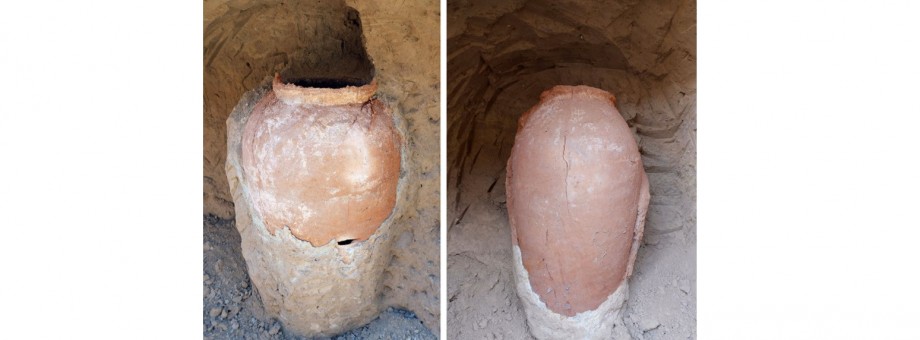Ceramics of Parthian age is found in Ashgabat

Construction workers have found the remains of ancient settlement during construction of underground communications at one of the parts of residential complex, which is built under the 16th phase of urban development, in the northwest part of Ashgabat. Accidentally, the bucket of excavator has hit the wall of huge ceramic vessel at the depth of 2 meters. It turned out to be a one meter jug. The works have been stopped immediately and according to the rules, information about the findings was sent to National Department for Protection, Study and Restoration of Historical and Cultural Monuments.
The group of archaeologists that came to the place has searched the pit and made excavation of surrounding territory. Two other completely intact jugs have been found in the result. All of them were located in one room of unknown building, which existed in this place many centuries ago. Specialists have easily identified the age and cultural belonging of the findings. It appeared to be Parthian jugs for storage of grain or liquids – chemical analysis of remains of interior walls of the vessels will identify exact purpose of the items.
The findings did not surprise historians – last two thousand years, the territory of modern Ashgabat and its outskirts was represented by network of strongholds, mansions and settlements located at significant distance from each other. Two big fortresses of Parthian period and number of small ruins could be observed in old Turkmen settlement of Kyoshy in the middle of the last century. The biggest hills was called Kyone-Kala by Turkmens. It was 13 meters in height and had remains of raw brick constructions.
Almost 70 years ago, Ashgabat university and school students from Young Historian Club under the leadership of Academic Alexander Roslyakov have researched the hills and discovered the remains of ceramic stoves and number of rooms filled with big jugs. Remains of burned grain were found in one of the jugs. Not far from Kyone-Kala They have also discovered a range of hills, which reminded the ruins of residential houses located separately at distance of several hundred meters from each other. Based on ceramic dishware found in this place, they were dated by Parthian period, even though many things indicated that people used to live in this place at later stage in Medieval period.
Strongholds, fortified settlements and castles of Ancient Ashgabat were located in an arc stretching from east to west and controlling not only important merchant routes but also protecting Parthiena and its main city of Nisa. The historians have a reason to say that settlements at the place of central part of modern Ashgabat has been represented by important city – the stronghold of Parthian period. It was surrounded by the underground irrigation (kyariz) system and had water supply network. The latter has also been discovered several decades ago next to Gulistan Shopping Centre (Russian Bazar) during laying of telephone cable and has been represented by the pipeline from well-tempered clay.
According to the scientists, this circumstance denies the myth that European part of the city has appeared on empty space in the end of XIX century. If we do not discover the construction, which is typical for other cities of Central Asia, it is a specific feature of Ahal cities. Organization of urban environment in the cities was based on defensive functions and was related to close combination of crafts and farming.


 NEWS
NEWS